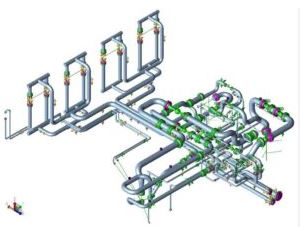
Electrical System Design

Subodh Sawant
Design Manager-Electrical Engineering (HOD)
$ 4286
Beginner course for learners

Electrical System Design
Trainers feedback
0
(0 reviews)
Subodh Sawant
Design Manager-Electrical Engineering (HOD)
Course type
Instructor led live training
Course duration
0 Hrs
Course start date & time
Coming in Next Month
Language
English
This course format is where trainer will explain you the subject via online live session. Date and time are not decided yet but it will be planned within next 2 weeks after you enroll & pay for this course?. Get in touch with our team if any clarification is required.
Why enroll
Master the skills needed for electrical system design and installation.
Learn to assess power requirements and conduct site surveys.
Understand regulatory standards (IEC, NEC) and ensure compliance.
Gain hands-on experience in selecting components and designing protection systems.
Design lighting systems and integrate energy-efficient solutions.
Learn about short circuit analysis, renewable energy integration, and automation.
Develop expertise in system commissioning and maintenance.
Prepare for career growth in sectors like construction, manufacturing, and utilities.
Practical knowledge to design and implement safe, reliable, and sustainable electrical systems.
Enroll today and shape the future of electrical engineering.
Opportunities that awaits you!

Earn a course completion certificate
Add this credential to your LinkedIn profile, resume, or CV. Share it on social media and in your performance review
Course details
Electrical System Design
( Course Duration in Hours : 60 Hrs.)
1. Understanding Requirements
Load Analysis: Identifying the power requirements for different electrical loads (machinery, lighting, HVAC, etc.).
Site Survey: Assessing the physical location for installation constraints.
Regulatory Standards: Reviewing applicable codes, such as IEC, NEC, or local standards.
2. Preliminary Design
Single-Line Diagram (SLD): Developing a simplified representation of the electrical distribution network, showing how the main components (transformers, switchgear, etc.) are connected.
Load Calculation: Determining power consumption and sizing the electrical system components (transformers, switchgear, cables) based on demand.
Power Source Design: Deciding on the type of power source (utility grid, generators, renewable energy sources).
3. Component Selection
Cables and Wiring: Choosing appropriate conductor sizes based on current ratings and voltage drops.
Transformers: Selecting transformers based on load demand, voltage levels, and system configuration.
Switchgear & Protection Devices: Sizing circuit breakers, fuses, and relays for system protection.
Earthing/Grounding: Designing an effective earthing system to prevent electrical hazards.
4. System Protection Design
Short Circuit Analysis: Evaluating the potential fault current in the system and selecting devices to protect against overcurrent and short circuits.
Coordination Study: Ensuring that protection devices (relays, breakers) are coordinated for proper fault isolation without unnecessary downtime.
Arc Flash Study: Assessing potential arc flash hazards and designing the system to mitigate risks.
5. Lighting Design
Interior/Exterior Lighting: Designing lighting systems based on luminance requirements and energy efficiency standards.
Emergency Lighting: Integrating emergency and exit lighting for safety in case of power failure.
6. Distribution System Design
Cable Routing: Planning cable trays, conduits, and routing paths for minimal interference.
Busbar Design: For high-power systems, busbar sizing and configuration need to be considered.
7. Control and Automation
Building Automation Systems (BAS): Integrating controls for lighting, HVAC, and security systems.
Supervisory Control and Data Acquisition (SCADA): Designing SCADA systems for monitoring and controlling electrical equipment.
8. Energy Efficiency & Sustainability
Energy Auditing: Incorporating energy-saving strategies and selecting energy-efficient equipment.
Renewable Integration: Designing systems for solar, wind, or other renewable sources where applicable.
9. Documentation and Approvals
Detailed Drawings: Creating final circuit diagrams, layouts, and equipment details.
Bill of Materials (BOM): Listing all components required for installation.
Compliance Review: Ensuring the design meets regulatory requirements and securing necessary permits.
10. Installation and Commissioning
Installation Supervision: Overseeing the installation process to ensure it matches the design.
Testing & Commissioning: Conducting tests to validate system performance, including insulation resistance, continuity checks, and functional testing of protection systems.
11. Operation & Maintenance Planning
Maintenance Strategy: Developing a preventive maintenance plan for the system.
As-Built Drawings: Updating design documents to reflect any changes made during construction for future reference.
Course suitable for
Oil & Gas Energy & Utilities Automotive Electrical Instrumentation Health, Safety & Environmental
Key topics covered
1. Understanding Requirements
Load Analysis: Identifying the power requirements for different electrical loads (machinery, lighting, HVAC, etc.).
Site Survey: Assessing the physical location for installation constraints.
Regulatory Standards: Reviewing applicable codes, such as IEC, NEC, or local standards.
2. Preliminary Design
Single-Line Diagram (SLD): Developing a simplified representation of the electrical distribution network, showing how the main components (transformers, switchgear, etc.) are connected.
Load Calculation: Determining power consumption and sizing the electrical system components (transformers, switchgear, cables) based on demand.
Power Source Design: Deciding on the type of power source (utility grid, generators, renewable energy sources).
3. Component Selection
Cables and Wiring: Choosing appropriate conductor sizes based on current ratings and voltage drops.
Transformers: Selecting transformers based on load demand, voltage levels, and system configuration.
Switchgear & Protection Devices: Sizing circuit breakers, fuses, and relays for system protection.
Earthing/Grounding: Designing an effective earthing system to prevent electrical hazards.
4. System Protection Design
Short Circuit Analysis: Evaluating the potential fault current in the system and selecting devices to protect against overcurrent and short circuits.
Coordination Study: Ensuring that protection devices (relays, breakers) are coordinated for proper fault isolation without unnecessary downtime.
Arc Flash Study: Assessing potential arc flash hazards and designing the system to mitigate risks.
5. Lighting Design
Interior/Exterior Lighting: Designing lighting systems based on luminance requirements and energy efficiency standards.
Emergency Lighting: Integrating emergency and exit lighting for safety in case of power failure.
6. Distribution System Design
Cable Routing: Planning cable trays, conduits, and routing paths for minimal interference.
Busbar Design: For high-power systems, busbar sizing and configuration need to be considered.
7. Control and Automation
Building Automation Systems (BAS): Integrating controls for lighting, HVAC, and security systems.
Supervisory Control and Data Acquisition (SCADA): Designing SCADA systems for monitoring and controlling electrical equipment.
8. Energy Efficiency & Sustainability
Energy Auditing: Incorporating energy-saving strategies and selecting energy-efficient equipment.
Renewable Integration: Designing systems for solar, wind, or other renewable sources where applicable.
9. Documentation and Approvals
Detailed Drawings: Creating final circuit diagrams, layouts, and equipment details.
Bill of Materials (BOM): Listing all components required for installation.
Compliance Review: Ensuring the design meets regulatory requirements and securing necessary permits.
10. Installation and Commissioning
Installation Supervision: Overseeing the installation process to ensure it matches the design.
Testing & Commissioning: Conducting tests to validate system performance, including insulation resistance, continuity checks, and functional testing of protection systems.
11. Operation & Maintenance Planning
Maintenance Strategy: Developing a preventive maintenance plan for the system.
As-Built Drawings: Updating design documents to reflect any changes made during construction for future reference.
Training details
This is a live course that has a scheduled start date.
Live session
Why people choose EveryEng
Industry-aligned courses, expert training, hands-on learning, recognized certifications, and job opportunities—all in a flexible and supportive environment.
- Industry Veteran
- Trainer Review
$ 4286
- $ 0 Early bird discount
Coming in Next Month
Questions and Answers
A: An electrical distribution system primarily consists of transformers, switchgear, circuit breakers, busbars, and protective relays. Transformers step down high voltage electricity to lower voltages suitable for end-users. Switchgear controls the flow of electricity and provides protection by enabling the isolation of equipment. Circuit breakers interrupt faulty circuits to prevent damage. Busbars serve as a junction point for power distribution. Protective relays detect faults and trigger circuit breakers. For more detailed information, you can refer to the IEEE Power & Energy Society resources at https://www.ieee-pes.org/.
A: Load demand calculation involves estimating the total power consumption of all electrical devices connected to the system. This includes assessing the power rating (in kW or VA) and the duty cycle of each device. The diversity factor and demand factor are applied to account for simultaneous usage and variability. The general formula is: Total Load = Sum of individual loads × Diversity Factor × Demand Factor. Understanding these factors is crucial for accurate design to avoid under-sizing or over-sizing equipment. The National Electrical Code (NEC) Handbook provides useful guidelines for load calculations: https://www.nfpa.org/nec.
A: AC (Alternating Current) and DC (Direct Current) systems differ primarily in the direction of current flow. AC current periodically reverses direction, while DC flows in a single direction. AC systems are commonly used for power distribution due to their ability to easily transform voltages using transformers, which makes long-distance transmission efficient. DC is often used in battery-powered devices, electronics, and applications requiring stable voltage supply. Additionally, AC systems can be more complex due to phases and harmonics, whereas DC systems are simpler but may have higher transmission losses over long distances. For deeper insight, visit: https://www.energy.gov/eere/vehicles/articles/ac-vs-dc-electricity.
A: Protective relays are devices that monitor electrical circuits for abnormal conditions such as faults or overloads. They detect these issues and send signals to circuit breakers to isolate the faulty part, preventing damage to equipment and ensuring safety. Protection relays enhance the reliability and stability of electrical systems by minimizing outage durations and preventing cascade failures. Modern protection relays can be electromechanical, solid-state, or digital (microprocessor-based). Understanding their operation is fundamental for designing secure and robust electrical systems. More details can be found at the IEEE guide on Protection and Control: https://resourcecenter.ieee-pes.org/protection-control.
A: Selecting a transformer rating involves estimating the maximum load that will be connected, considering future expansion, and including safety margins. Key factors include the total connected load (in kVA), load types (continuous or intermittent), ambient temperature, and installation conditions. Transformers should be sized to operate near their rated capacity for efficiency but avoid running overloaded to reduce overheating risks. It's also vital to consider standards such as ANSI and IEEE guidelines. A practical approach is to select a transformer with a rating about 20-25% higher than peak calculated load. Comprehensive selection criteria are available in the IEEE Transformer Guide: https://standards.ieee.org/standard/C57_91-2011.html.
More from Same Author
- Technical Courses
- Articles
4 (19)
Watch to learn anytime
28
E-Learning
Unlimited access
Instructor led live training
118
Online
Live courses
October 13
15 Hrs
5
Instructor led live training
893
195
Online
Live courses
September 15
1 Hrs
Earning and Growth option in same Industry Domain
- Pre-recorded
- Online live session
- Offline
- Articles
4
Watch to learn anytime
961
2
E-Learning
Unlimited access
Watch to learn anytime
1603
E-Learning
Unlimited access
4
Watch to learn anytime
1958
10
E-Learning
Unlimited access
More Training & Development option to expand your reach
- Technical courses
- Soft-skill courses
- Seminars & Conferences
- Articles & Blogs
5
Instructor led live training
459
1
Online
Live courses
September 22
9 Hrs
Beginner
4 (23)
Instructor led live training
335
1
Online
Live courses
October 11
14 Hrs
Advanced
4 (23)
Instructor led live training
541
Online
Live courses
October 11
4 Hrs
Intermediate


























